|
The year began on a mild note, which has become the norm when compared to the last several years. New Year’s day was a tad chilly, with low temperatures falling below zero. Within a few a days though, temperatures warmed to the mild readings the area has become accustom to. In fact, to find the last abnormally “cool” January one would have to travel back to 1996. That year, temperatures were 2 ½ degrees below normal. January of 2001 was also devoid of snow for the most part, with any significant snow storms skirting the area. The total of 4.3 inches was about half of normal.
|
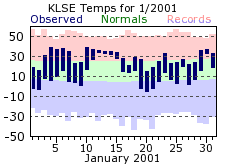 |
| |
|
|
February made it look like the mild winter would continue...until mid-month that is. Temperatures took an about face from the 9th to the 10th, with highs going from 32 to 9 degrees. The month then stayed mostly near or below normal. Although temperatures felt more like winter, a “deep freeze” was avoided. Only 9 days recorded below zero readings, which is near normal for February.
|
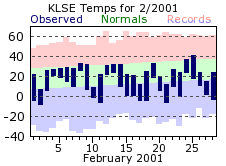 |
| |
|
March continued the cooler than normal conditions, and it was also dry...except for one day. The last winter storm of the season would plow a path through the region on 12th, working shovels to the tune of 7.5 inches in the La Crosse area. This late winter/early spring snow storm is not unprecedented. To the contrary, it is more the normal for the Upper Midwest. Every few years a winter storm of this magnitude effects the region, and the area was definitely due for a storm of this strength. The last significant late winter/early spring snow storm can be traced back to 1997, and was quite a doozy, dropping over 19 inches of the white stuff in a 3 day period. Still, if it wasn’t for this storm, March would have even been drier than it was. On only 5 days was measurable precipitation recorded, and there was a streak of 9 consecutive days without even a trace of precipitation.
|
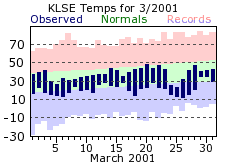 |
| |
|
April brought a reversal of fortune when it came to precipitation, and to a fault. La Crosse was nearly 2 inches above normal for the month, and this in concert with even more significant rainfall to the north, led to the worst Mississippi river flooding in about 40 years. The river crested at mid to late month, and was the 2nd or 3rd highest crest on record for most locations along the upper Mississippi. In La Crosse, the crest of 16.41 feet on April 18th was the 3rd highest on record. River levels would not drop quickly though, staying above the 12 foot flood stage in La Crosse until May 15th. So technically, the La Crosse area was in flood from April 12th through May 15th...a span of 33 days. Even with the abundance of rain, temperatures were above normal for April. Temperatures cracked both the 70 and 80 degree barriers for the first time in 2001 on the 20th, with an 81 degree day.
|
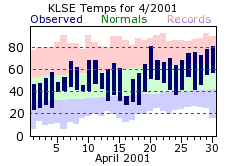 |
| |
|
The wet weather continued in May, with monthly totals over 1 ½ inches above normal. The precipitation came in streaks, with 6 straight days with rainfall to start off the month, and another 7 consecutive days toward the end of the month. In between those, there was a 9 day span without even a drop of rain. During that dry period, the area got an early taste of summer, with a few 80 degree days and the first 90 degree day on the 15th. This taste of warmth would be misleading though, as cooler conditions settled in for month’s end, and would continue through the first part of June.
|
 |
| |
|
|
The streak of cool conditions would jump back into summer-time warmth after the first week of June, and then continue near or above normal for the rest of the month. June was also the most active month in terms of severe weather, with hail being the main severe weather event. The first of the traditional summer months would be wet through the middle to late part of the month, then turn dry. This would be the start of the most significant streak of dry days the area has seen in a few years. What made it even more significant was its timing. Coming during the heart of summer as it did, the long and hot days would have a maximum impact upon area plant life.
|
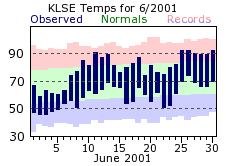 |
| |
|
La Crosse would go until July 17th before it would receive any measurable precipitation, a streak of 25 straight days. Area lawns and foliage took a beating as sprinklers worked overtime to compensate for the arid conditions. The last significant dry spell prior to this was in March of 1999, but due to its timing, did not have as big an impact on the area. Heat was also a factor for July with 12 days of 90 degree of better readings. La Crosse would even reach 100 on the 31st, its first 100 degree day since 1999. As opposed to June, July was very quiet in regards to severe weather, as would be August.
|
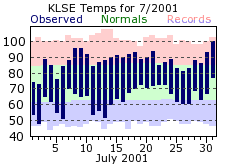 |
| |
|
Yet more dry conditions would settle in for the start of August, leading to more worries of an extended drought. After over 1/3 of an inch on the 1st, there were another 13 straight days without any measurable precipitation. Mother Nature would finally relent by mid month, and much needed rain would fall on over half of the remaining days in August. And even after the dry start, August would finish ½ inch above normal for rainfall. Heat continued to be a story for the first part of August, and came hand in hand with the dry streak. There was a streak of 11 days with 90 degree or greater heat that started at the end of July and ended on August 9th. This streak was the 3rd longest of its type recorded for La Crosse, with an average high temperature of 94.6 degrees through the period.
|
 |
| |
|
September transitioned quickly from the warmth of the summer months, to temperatures more typical of early October. Rainfall for the month was also above normal, but not very beneficial. The bulk of the rain fell on two days, the 6th and 7th. The total of 3.67 inches on those days accounted for two-thirds of the monthly total.
|
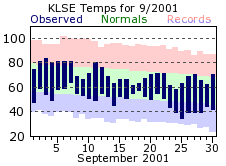 |
| |
|
October was slightly below normal for both temperatures and precipitation, with an interesting swing at the start of the month. On the 2nd, the last 80 degree or greater day graced the area, which is the usual occurrence of this. However, the first freezing day of the early fall season would come quickly on its heels, with a 29 degree reading on the morning of the 6th. Interestingly enough, this was only a few days ahead of the first normal occurrence of this. The first few flurries of the new snowfall season also came on the 6th, with a trace of snow falling at the airport. Wind was also a story for October, with strong and gusty winds on the 25th and 26th. Winds averaged over 27 mph on the 25th, with a peak gust around 50 mph. With high temperatures right around 40 degrees for both days, wind chills also became a factor.
|
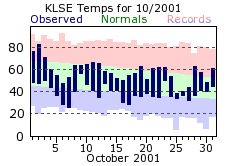 |
| |
|
November made it feel more like early spring rather than the tail end of fall, and ended up as the warmest November on record at 47.5 degrees. This thoroughly crushed the old record of 43.2 degrees, which was set in 1931. November was the only month of this past year where every day averaged above normal, and low temperatures only dropped to freezing on 6 occasions. This is well under the normal number of 20 such days. The last 70 degree day of the year also happened in November, on the 15th. This was about a week off of the record for latest 70 degree occurrence, which is November 21st of 1991 for La Crosse.
|
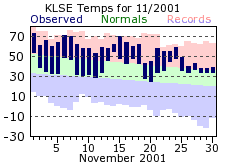 |
| |
|
|
December continued the string of above normal temperatures, not recording a below normal day until Christmas Eve. This marked the end of a string of 57 consecutive days with above normal temperatures (Oct. 28th through Dec 23rd). This it the longest string of above normal temperatures since the El Nino winter of 1998. The abnormally mild conditions also led to more unusual weather...the lack of snow. The first measurable snowfall of the season did not fall on La Crosse until the 23rd. A bit over ½ inch fell that day and insured, in the nick of time, a white Christmas. This first occurrence obliterated the old record for latest first measurable snowfall, which was December 7th in 1969. On average, the usual first measurable snowfall comes around November 19th. Temperatures and conditions more suitable for the season then rounded out the month.
|
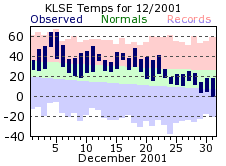 |
| |
|
|
This past year can best be described as a year of streaks, and made for the most interesting weather stories for 2001. Whether it be extended cold or hot spells, or bouts with an abundance of rain or lack thereof...the La Crosse area was defined more by the extremes rather than the mundane.
|
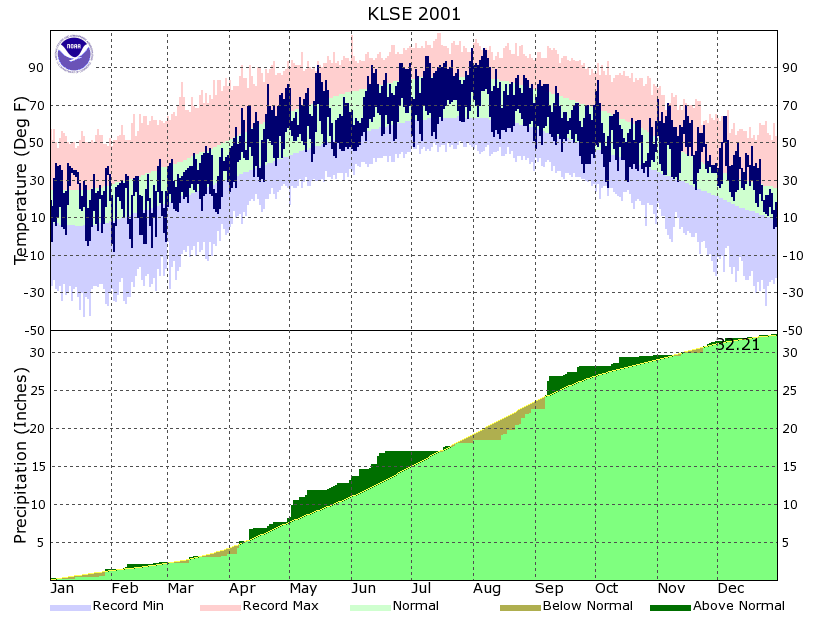 |
